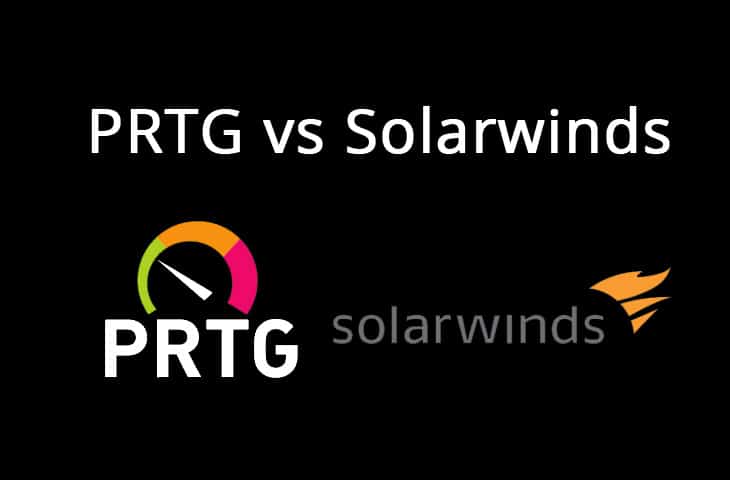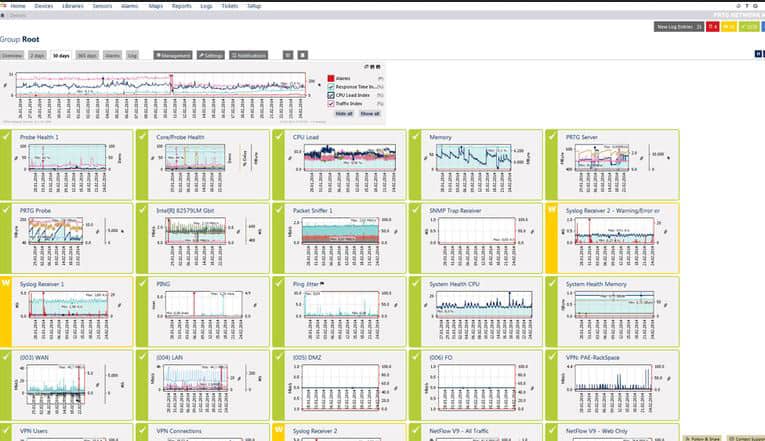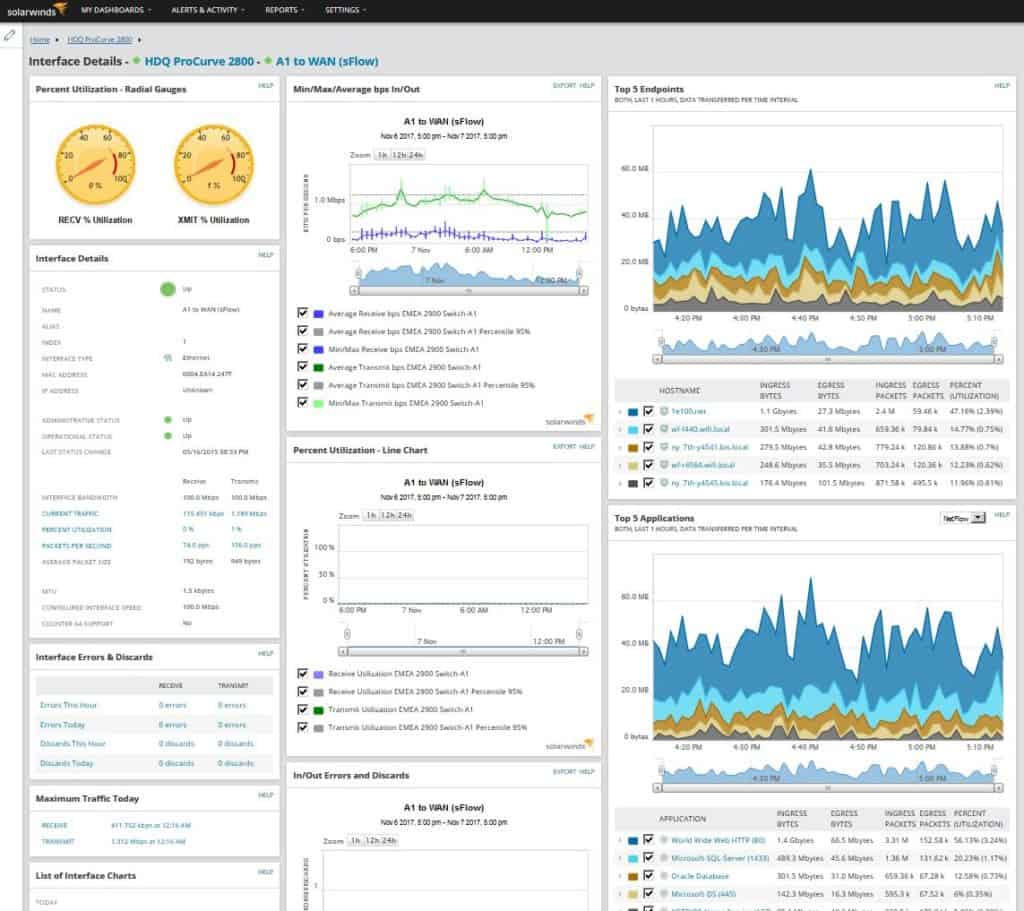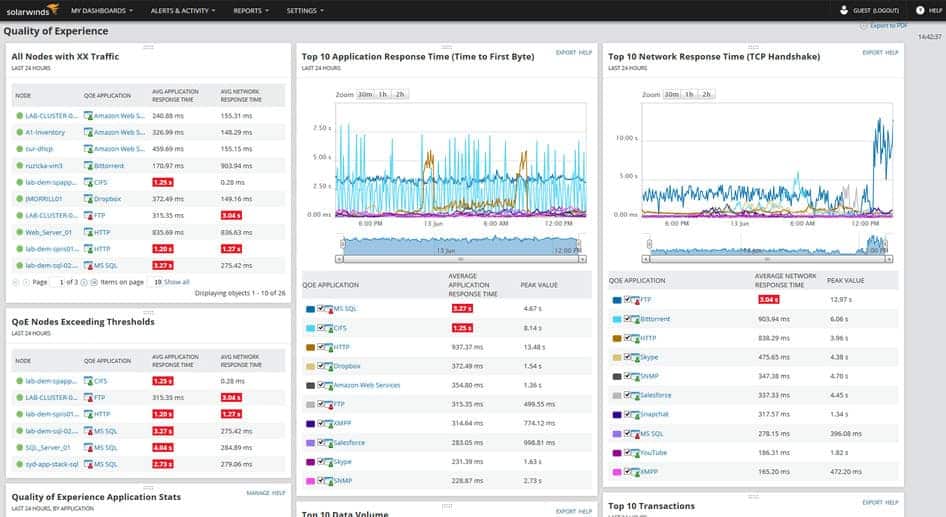When you are responsible for monitoring your organization’s IT infrastructure, you know how convenient it is to have a specialized application that does all of the hard work for you. We take two such products and look at some of the features that they can offer you in your day-to-day work life, as well as what the positives of each one are.
Being able to tell that a service, server, or application has started giving issues before any of your users or managers find out is priceless, and also makes you look like an IT superhero, although in most cases you will be happy that nobody noticed issues at all, leaving you in peace to continue with your actual work.
We will be looking at Paessler PRTG vs SolarWinds Network Performance Monitor (NPM), and how they compare to one another in this short product run-down.
Paessler PRTG – FREE TRIAL
Overview & Features
Paessler PRTG sees itself as an application suite that monitors every aspect of your IT infrastructure, and it isn’t wrong. It allows you to monitor all of your systems such as hardware devices, network traffic, server hardware, and more.
Key Features:
- Extensive Monitoring: Monitors all aspects of IT infrastructure, including hardware, network traffic, and server hardware.
- Easy Installation: Offers quick and straightforward setup, enhancing user experience from the start.
- Mobile Compatibility: Ensures monitoring capabilities are extended to mobile devices for on-the-go management.
- Broad Vendor Support: Features out-of-the-box compatibility with leading vendors like Oracle, AWS, Cisco, and more.
- Network Auto-Discovery: Automatically identifies and integrates new devices into the monitoring setup.
On the server hardware end of the spectrum, PRTG offers Dell, HP and IBM support, while your connectivity hardware is looked after with Cisco compatibility features as well, which is great news for anyone that needs to monitor such hardware.
It also features network auto-discovery, Maps for the ultimate in site visualization, alerts, and even has a free version for people to use as a trial.
Pros:
- Versatile Monitoring Approach: Combines packet sniffing, WMI, and SNMP for comprehensive network performance reporting.
- Dynamic Inventory Updates: Auto-discovery feature keeps inventory current with minimal manual intervention.
- User-Friendly Customization: Drag and drop editor simplifies the creation of custom views and reports.
- Multiple Alert Options: Offers a variety of alerting mechanisms, including SMS, email, and integration with third-party tools.
- Free Version Available: Provides a freeware version for trial use, making it accessible for initial evaluation.
Cons:
- Complexity: The platform's comprehensiveness may overwhelm new users, requiring time to fully grasp its functionalities.
- Sensor Configuration: Setting up custom sensors can be intricate and may present challenges without prior experience.
PRTG Pricing
The pricing varies a bit for the more comprehensive versions of the application, with 500 sensors costing around $1600, and the top of the range package with unlimited sensors costing $60,000.
So it is safe to say that if you are concerned about scaling your monitoring capabilities then PRTG will have you covered.
Official Site for Paessler PRTG: paessler.com/prtg/vs
Start the 30-day FREE Trial Here!
SolarWinds Network Performance Monitor – FREE TRIAL
Overview & Features
SolarWinds Network Performance Monitor (NPM) is another premium product that will greatly improve your network visibility, especially if you are monitoring multiple departments or sites from one centralized location.
Key Features:
- Comprehensive Network Visibility: Enhances monitoring across multiple departments or sites from a centralized platform.
- Multi-Functional Suite: Offers a blend of network and systems management, IT security, database management, IT help desk, and cloud solutions.
- Auto-Discovery: Automatically identifies network devices and their configurations using SNMP, ensuring up-to-date network topology and inventory.
NPM has multiple layers of IT functionality all rolled into one slick package, and they encompass all of the functionality of a network and systems management suite, a systems management application, IT security platform, data base management, an IT help desk solution and a cloud solution!
Which elements you decide to incorporate into your environment is entirely up to you, but for the purposes of our comparison we will be looking at the network monitoring functionality. NPM is able to identify all of your network devices via SNMP and it can also identify all related prompts from these devices as well.
Hardware monitoring is also possible via SolarWinds, which means that your servers, PCs and other network devices can all be looked at and monitored from the application.
Pros:
- Dynamic Network Mapping: Generates real-time network topology maps and inventory lists as new devices connect, promoting accurate network visibility.
- Advanced Alerting: Features sophisticated alert mechanisms that are both effective and user-friendly.
- Versatile Monitoring Options: Supports SNMP monitoring and packet analysis for granular control over network performance insights.
- Customizable Interface: Allows for personalization of the dashboard with drag-and-drop widgets for a tailored monitoring experience.
- Rich Template Library: Provides an extensive collection of preconfigured templates, reports, and dashboard views for quick setup and deployment.
Cons:
- Complexity for Non-Technical Users: The depth and breadth of features, while beneficial for sysadmins, may be daunting for users without technical expertise.
Official Site for SolarWinds NPM: solarwinds.com/network-performance-monitor
Start a 30-day FREE Trial Here!
PRTG vs NPM: Feature-by-Feature Comparison
|
PRTG |
NPM |
|
| Network Scanning, Auto Discovery, Mapping & Visualization Maps |
✔ |
✔ |
| WMI ICMP SNMP |
✔ |
✔ |
| DB Functionality and Alerts |
✔ |
✔ |
| SLA Monitoring |
✔ |
✔ |
| Hardware Monitoring |
✔ |
✔ |
| Web Server Monitoring |
✔ |
✔ |
| Active Directory Alerts and Monitoring |
✔ |
✔ |
| Reports and Graphs of Historic Trends |
✔ |
✔ |
| Smart Device App: iOS, Android |
✔ |
X |
| DOWNLOAD: | 30-day free trial | 30-day free trial |
We have a tight race here, with both of these products offering very similar functionality in the network monitoring side of things, and to add to that, there is also a lot of extra features that can be added with additional components from each company.
The solution that works best for you is going to be the one that scales correctly to your organization without affecting performance or your IT budget. PRTG is a great product suite, and it offers some good network scanning features. Installing the product is easy, and the network detection happens seamlessly when you are configuring your environment.
Once you set up PRTG, users can look at any aspect of their network without having to do too much work. Network auto-discovery is able to see all of the different segments of your network, and then label them accordingly, making the job of sorting and categorizing your online devices quick and easy.
Maps can also be generated, giving you a visual representation of what is going on within your network. Alerts can also be setup, so that whenever a specific event happens you can receive notifications as soon as an of your devices come up with any issues.
SolarWinds offers very similar functionality within its Network Performance Monitor suite. It features multi-vendor support for a wide range of products and devices, and also offers a key feature called ‘Network Insights' which will give you a detailed breakdown of what is happening on your network.
Intelligent maps is another feature that will keep you well informed, as will the network performance baselines. Advanced alerting also gives you a heads up whenever any applications, services or devices start to give issues, which is an excellent early warning system to have.
There are no clear winners here as the features and functionality of each are too close to call. The deciding factor here will be your budget and scalability options that you need to take into account. PRTG offers excellent scalability and will let you add monitoring to your setup for as long as you need, but this will come at a price premium.
SolarWinds offers similar scalability, but in order to find out pricing you will need to request a quote.
If you require a smaller installation size, or just a trial version, then both SolarWinds and PRTG can give you a small taste of what their software offers you for your specific needs.
Official Site for Paessler PRTG: paessler.com/prtg/vs
Start the 30-day FREE Trial Here!
Official Site for SolarWinds NPM: solarwinds.com/network-performance-monitor
Start a 30-day FREE Trial Here!
The best solution is to try both out and see which one works best for you, then make your decision based on the outcomes.
Happy monitoring and good luck!
Paessler PRTG vs SolarWinds NPM FAQs
What are Paessler PRTG and SolarWinds NPM?
Paessler PRTG and SolarWinds NPM are two popular network monitoring tools that provide real-time visibility into the health and performance of network infrastructure.
What are the key features of Paessler PRTG?
Paessler PRTG provides features such as network device monitoring, bandwidth monitoring, application monitoring, customizable dashboards, alerting and notifications, and reporting.
What are the key features of SolarWinds NPM?
SolarWinds NPM provides features such as network device monitoring, bandwidth monitoring, network topology mapping, network configuration management, and performance analysis.
What is the difference between Paessler PRTG and SolarWinds NPM?
Paessler PRTG and SolarWinds NPM both offer similar features for network monitoring, but they differ in their approach and user interface. PRTG is known for its ease of use and simplicity, while SolarWinds NPM is known for its scalability and advanced features.
How much does Paessler PRTG cost?
Paessler PRTG offers a range of pricing plans based on the number of sensors required, starting at $1,750 for 500 sensors.
How much does SolarWinds NPM cost?
SolarWinds NPM offers a range of pricing plans based on the number of network elements required, starting at $2,955 for up to 100 elements.
Which tool is better for small businesses?
Paessler PRTG is a popular choice for small businesses due to its ease of use, affordable pricing, and scalability.
Which tool is better for large enterprises?
SolarWinds NPM is a popular choice for large enterprises due to its advanced features, scalability, and ability to handle large-scale network environments.








